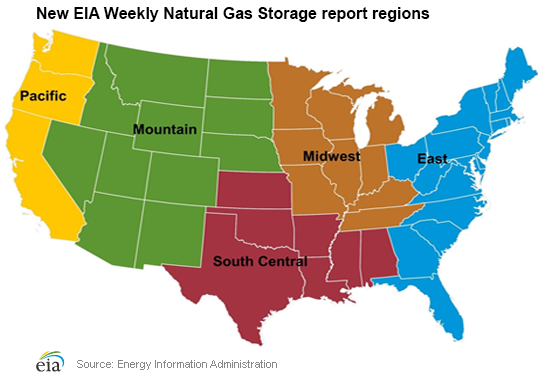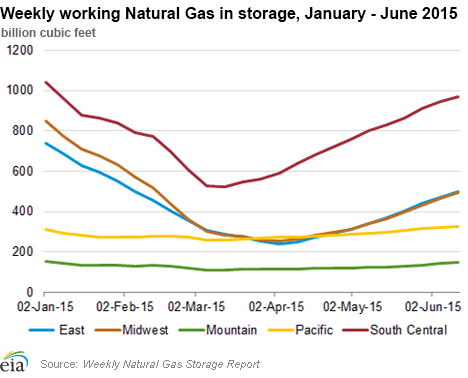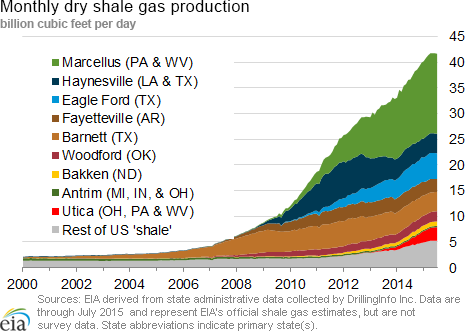In the News:
EIA provides historical data for new storage regions
Later this year, EIA will change its regional breakdown of working gas storage data in the Weekly Natural Gas Storage Report to include five regions, rather than the current three regions. The new regions will provide further reporting granularity and better connect the location of underground storage facilities with the markets they serve, as well as to accommodate changes in major producing areas of the United States over the past several years. Last week, EIA released data on weekly working gas storage levels in the five regions from January 1, 2010, through June 12, 2015. Five-year (2010 – 14) average, maximum, and minimum storage levels are also available for the weeks in 2015.
Of the new regions, the South Central generally had the highest storage levels over the five years of data. Inventories in the South Central group as of June 12 were 10.3% greater than the five-year average level. The new South Central region largely overlaps with the old Producing region, and includes the states of Alabama, Arkansas, Kansas, Louisiana, Mississippi, Oklahoma, and Texas. (The old Producing region included all of these states, plus New Mexico). The South Central region will include a breakout by salt and nonsalt storage facilities.
The Midwest and East are second and third largest storage regions, respectively, by capacity and gas-in-storage. These two regions largely correlate with the current East region. Similar to the current, larger, East region, as of June 12, the new East and Midwest regions were 7.8% and 10.9% less than their five-year averages, respectively. This is because of a very cold winter in 2013–14, which led to an inventory drawdown that left stocks well below their five-year minimums.
The Pacific and Mountain regions mainly overlap with the former West region, and as of June 12, inventories in these regions exceeded their five-year average, following a warmer than normal 2014-15 winter in the western part of the United States.
EIA will announce public testing of the new regional formats later this month. Readers can receive announcements of the public testing dates and other news about the Weekly Natural Gas Storage Report by signing up for the Underground Natural Gas Storage email update list.
Overview:
(For the Week Ending Wednesday, August 9, 2015)
- Natural gas spot prices were relatively flat at most market locations over the report week (Wednesday, September 2 through Wednesday, September 9). The Henry Hub spot price began the week at $2.71 per million British thermal units (MMBtu) last Wednesday and ended the week at $2.73/MMBtu.
- At the New York Mercantile Exchange (Nymex), the October contract began the report week at $2.648/MMBtu and ended at $2.651 yesterday.
- Working natural gas in storage increased to 3,261 Bcf as of Friday, September 4. A net injection into storage of 68 Bcf for the week resulted in storage levels 17% above a year ago and 4% above the five-year average for this week.
- The total oil and natural gas rig count fell by 13 from the previous week, with 864 units in service for the week ending Friday, September 4, according to data from Baker Hughes Incorporated. A decline in the number of oil rigs accounted for all of the change in the rig count. Oil rigs decreased to 662 units, while natural gas rigs remained at 202 units.
- The composite price for natural gas plant liquids at Mont Belvieu, Texas, increased by 56¢/MMBtu to $4.75/MMBtu, up 13.5 % for the week ending September 4. All natural gas liquids spot prices, with the exception of ethane, rose this week, with natural gasoline up 17.9%, propane up 18.6%, butane up 13.8%, and isobutane up 13.4%, while ethane dropped 0.5%. WTI crude oil prices increased this week by 10%, moving above $46/barrel, likely applying some upward pressure to natural gas liquids prices.
Prices/Demand/Supply:
Prices outside the Northeast remain fairly flat, most varying less than a dime. Temperatures were above average for most of the nation at the start of the report week, then cooled to below average in the western half of the nation by the weekend. The Henry Hub spot price began the report week at $2.71/MMBtu last Wednesday, dipped slightly through the Labor Day holiday, and settled yesterday up 2¢ at $2.73/MMBtu. Prices at other market locations fluctuated slightly. The Chicago Citygate price began the week at $2.79/MMBtu and closed yesterday at $2.75/MMBtu. The Pacific Northwest saw some supply constraints from Canada as a result of maintenance issues, which put minor pressure on prices at Sumas, the U.S./Canada border crossing. The Sumas price closed at $2.55/MMBtu on Wednesday, a gain of 5¢ for the week. Prices at PG&E Citygate, serving Northern California, rose by 9¢ over the report week, closing at $3.19/MMBtu yesterday.
Northeast prices dipped some through the holiday, but rise at the end the report week with maintenance and increased power burn. With moderate temperatures and low holiday weekend demand, Northeast prices fell on Thursday and Friday, but increased with warmer temperatures on Tuesday and Wednesday. Spot prices at the Algonquin Citygate, serving Boston, started the report week at $3.14/MMBtu, fell 15¢ on Friday to $2.99/MMBtu, then increased Tuesday to $3.67/MMBtu, likely because of increasing temperatures and compressor maintenance. Maintenance at the Chaplin and Cromwell stations in Connecticut and at Stony Point in New York may limit capacity along the Algonquin Pipeline by as much as 25%. These maintenance outages are scheduled to continue until the third week in September. Maintenance on Algonquin's Southeast compressor in New York, which began yesterday and is scheduled to end on September 11, will add slightly to these constraints. Algonquin Citygate spot prices ended the week up at $3.71/MMBtu yesterday. Tennessee Zone 6 200L, serving lower New England, followed a similar pattern, beginning the week at $3.12/MMBtu, dipping for the holiday weekend, and ending the week at $3.58/MMBtu. At Transcontinental Pipeline's Zone 6, serving New York City, the spot price started the report week at $2.84/MMBtu, dropped by more than $1 on Friday (to $1.79/MMBtu) for the weekend, and then rose to $2.85/MMBtu on Tuesday, ending the week down at $2.66 yesterday.
Marcellus prices remain low. Natural gas spot prices in the Marcellus region, among the lowest in the country, rose at several trading points this report week. On the Transco Leidy Line, prices started the week at $1.21/MMBtu last Wednesday and remained flat to close at $1.20/MMBtu yesterday. At Dominion South, which serves customers in portions of Pennsylvania, Ohio, Maryland, West Virginia, and Virginia, prices rose from $1.32/MMBtu last Wednesday to $1.41 yesterday. At Tennessee's Zone 4 Marcellus trading location, prices were flat through the holiday weekend, beginning at $1.04/MMBtu last Wednesday, but rising to end the week at $1.14/MMBtu.
Nymex prices rise slightly. At the New York Mercantile Exchange (Nymex), the October contract began the week at $2.648/MMBtu and ended the report week up slightly, at $2.651 yesterday. The 12-month strip, which is the average of Nymex prices from October 2015 through September 2016 , closed at $2.885/MMBtu yesterday, up 3¢/MMBtu from the week-ago price.
Supply remains flat. Dry natural gas production averaged 72.5 Bcf/d for the report week, 0.2% above that of the previous week, and 4.1% higher than the same period last year, according to Bentek Energy data. On Thursday, September 3, the Northeast had record high dry natural gas production of 20.5 Bcf/d. Imports of natural gas from Canada fell by 6.5%, and liquefied natural gas sendout decreased by 14.4%, averaging less than 0.3 Bcf/d. Overall, supply was down from the previous report week by 0.4%.
Consumption decreases slightly. U.S. consumption of natural gas decreased 0.8% for the week, led by a 1.9% decrease in natural gas used by the industrial sector. Total power burn increased by 1%, this week, with power burn in the Rockies and the Southwest both decreasing by 14%, likely because of cooler temperatures in those regions. U.S. exports to Mexico increased by 6.8% week-over-week, and they were 30% greater than during the same time last year.
Storage
Net storage injection is higher than the five-year average, but lower than last year's build for the report week. The net injection reported for the week ending September 4 was 68 billion cubic feet (Bcf), down from 94 Bcf the previous week. This injection compares with the five-year average increase of 63 Bcf for the week and last year's increase of 90 Bcf. Working gas inventories for the report week totaled 3,261 Bcf, 473 Bcf (17%) higher than last year at this time and 127 Bcf (4%) higher than the five-year (2010-14) average.
Storage injections are smaller than market expectations. Market expectations, on average, called for a build of 75 Bcf for this week. When the EIA storage report was released at 10:30 a.m. on September 10, the price for the October natural gas futures contract rose a few cents to about $2.71/MMBtu in Nymex futures trading. In the next hour, the price oscillated between $2.70 and $2.73/MMBtu.
From the week ending April 3 (the beginning of the injection season) through the week ending September 4, net storage injections totaled 1,800 Bcf, or 155 Bcf lower than the 1,955 Bcf injected during the same 23 weeks in 2014. During these weeks for the years 2010-14, net injections into storage averaged 1,483 Bcf. The estimated average unit value of the natural gas put into storage from April 3 to September 4 this year is $2.76/MMBtu, 36% lower than the average value of $4.34/MMBtu for the same 23 weeks last year. The highest winter-month Nymex price (for the January 2016 contract) in trading for the week ending September 4 averaged $3.01/MMBtu. This price is 33¢/MMBtu more than the October Nymex contract price. A year ago, the difference was 29¢/MMBtu.
In the Short-Term Energy Outlook (STEO) released on September 9, EIA forecasts that end-of-October natural gas inventories will reach 3,840 Bcf, 35 Bcf (0.9%) higher than the five-year average for that time. This month's forecast is 27 Bcf lower than the end-of-October inventory that EIA forecast in the August STEO, a change based on lower-than-anticipated injection levels during August. There are currently eight more weeks in the injection season, which traditionally runs from April 1 through October 31, although in many years injections continue into November. In order to reach 3,840 Bcf, injections need to average 72 Bcf per week through the end of October. EIA's forecast for the end-of-October inventory level is above the five-year (2010-14) average peak storage value of 3,805 Bcf. To reach the five-year average peak value, weekly injections through the end of October would need to average 68 Bcf.
Temperatures during the storage report week are warmer than normal. Temperatures in the Lower 48 states averaged 75° for the storage report week, 3° warmer than the 30-year normal temperature and 1° cooler than the average temperature during the same week last year. There were 70 population-weighted cooling degree days (CDD) this report week, 4 CDD fewer than the five-year average and 5 CDD fewer than during this week last year.
See also:
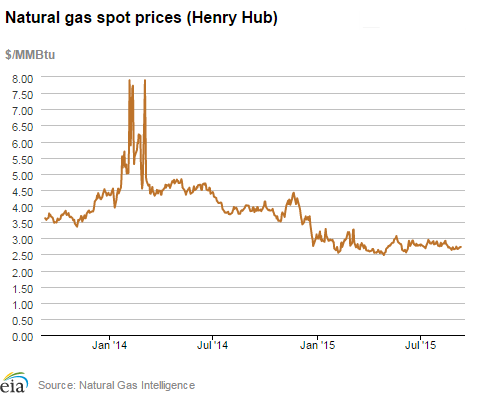
| Spot Prices ($/MMBtu) | Thu, 3-Sep |
Fri, 4-Sep |
Mon, 7-Sep |
Tue, 8-Sep |
Wed, 9-Sep |
|---|---|---|---|---|---|
| Henry Hub |
2.68 |
2.66 |
Holiday |
2.68 |
2.74 |
| New York | 2.27 |
1.79 |
Holiday |
2.85 |
2.66 |
| Chicago | 2.72 |
2.70 |
Holiday |
2.80 |
2.75 |
| Cal. Comp. Avg,* |
2.78 |
2.71 |
Holiday |
2.92 |
2.91 |
| Futures ($/MMBtu) | |||||
| October Contract | 2.664 |
2.715 |
Holiday |
2.702 |
2.648 |
| November Contract | 2.745 |
2.792 |
Holiday |
2.771 |
2.720 |
| *Avg. of NGI's reported prices for: Malin, PG&E citygate, and Southern California Border Avg. | |||||
| Source: NGI's Daily Gas Price Index | |||||
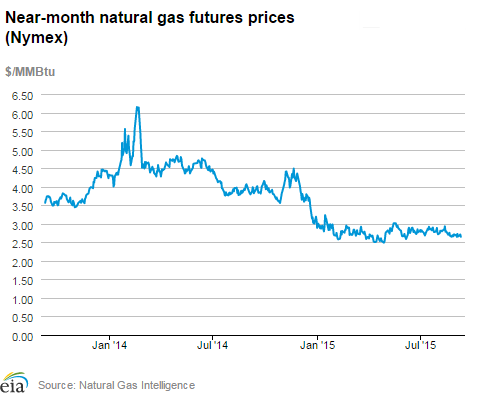
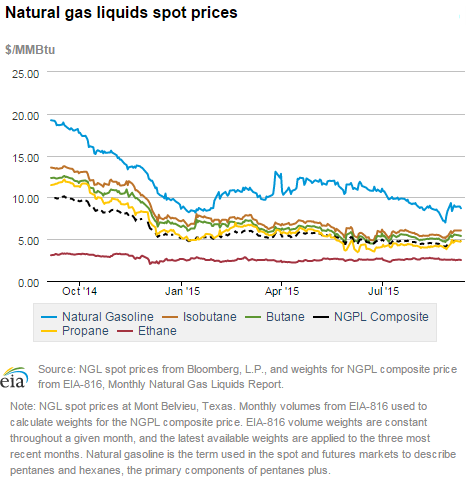
| U.S. natural gas supply - Gas Week: (9/2/15 - 9/9/15) | ||
|---|---|---|
Percent change for week compared with: |
||
last year |
last week |
|
| Gross production | 4.18%
|
0.17%
|
| Dry production | 4.14%
|
0.17%
|
| Canadian imports | 0.20%
|
-6.55%
|
| West (net) | 15.70%
|
1.47%
|
| Midwest (net) | -14.96%
|
-11.80%
|
| Northeast (net) | 333.33%
|
-142.81%
|
| LNG imports | 140.49%
|
-14.37%
|
| Total supply | 4.09%
|
-0.36%
|
| Source: BENTEK Energy LLC | ||
| U.S. consumption - Gas Week: (9/2/15 - 9/9/15) | ||
|---|---|---|
Percent change for week compared with: |
||
last year |
last week |
|
| U.S. consumption | 4.9%
|
-0.8%
|
| Power | 15.5%
|
1.0%
|
| Industrial | -3.5%
|
-1.9%
|
| Residential/commercial | -5.6%
|
-3.4%
|
| Total demand | 5.8%
|
-0.5%
|
| Source: BENTEK Energy LLC | ||
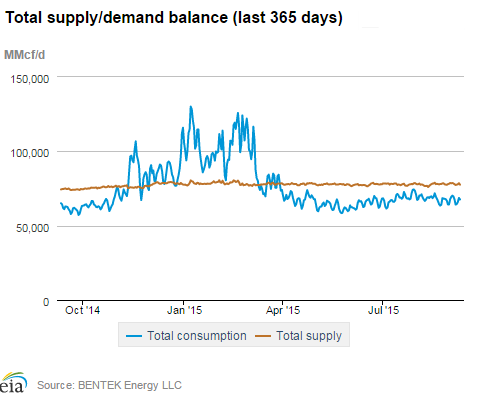
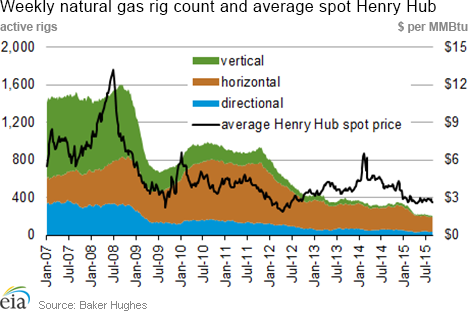
| Rigs | |||
|---|---|---|---|
Fri, September 04, 2015 |
Change from |
||
last week |
last year |
||
| Oil rigs | 662 |
-1.93% |
-58.21% |
| Natural gas rigs | 202 |
0.00% |
-40.59% |
| Miscellaneous | 0 |
0.00% |
-100.00% |
| Rig numbers by type | |||
|---|---|---|---|
Fri, September 04, 2015 |
Change from |
||
last week |
last year |
||
| Vertical | 120 |
-4.00% |
-67.39% |
| Horizontal | 659 |
-1.93% |
-50.56% |
| Directional | 85 |
6.25% |
-62.05% |
| Source: Baker Hughes Inc. | |||
| Working gas in underground storage | ||||
|---|---|---|---|---|
Stocks billion cubic feet (bcf) |
||||
| Region | 2015-09-04 |
2015-08-28 |
change |
|
| East | 1,630 |
1,581 |
49 |
|
| West | 487 |
482 |
5 |
|
| Producing | 1,144 |
1,130 |
14 |
|
| Total | 3,261 |
3,193 |
68 |
|
| Source: U.S. Energy Information Administration | ||||
| Working gas in underground storage | |||||
|---|---|---|---|---|---|
Historical comparisons |
|||||
Year ago (9/4/14) |
5-year average (2010-2014) |
||||
| Region | Stocks (Bcf) |
% change |
Stocks (Bcf) |
% change |
|
| East | 1,513 |
7.7 |
1,667 |
-2.2 |
|
| West | 436 |
11.7 |
469 |
3.8 |
|
| Producing | 838 |
36.5 |
997 |
14.7 |
|
| Total | 2,788 |
17.0 |
3,134 |
4.1 |
|
| Source: U.S. Energy Information Administration | |||||
| Temperature -- heating & cooling degree days (week ending Sep 03) | ||||||||
|---|---|---|---|---|---|---|---|---|
HDD deviation from: |
CDD deviation from: |
|||||||
| Region | HDD Current |
normal |
last year |
CDD Current |
normal |
last year |
||
| New England | 2
|
-8
|
-3
|
42
|
24
|
-1
|
||
| Middle Atlantic | 1
|
-4
|
-1
|
59
|
30
|
9
|
||
| E N Central | 6
|
-4
|
4
|
54
|
25
|
1
|
||
| W N Central | 3
|
-12
|
0
|
63
|
23
|
8
|
||
| South Atlantic | 0
|
-1
|
0
|
89
|
11
|
-14
|
||
| E S Central | 0
|
-1
|
0
|
80
|
9
|
-17
|
||
| W S Central | 0
|
-1
|
0
|
107
|
1
|
-15
|
||
| Mountain | 1
|
-17
|
-6
|
73
|
16
|
9
|
||
| Pacific | 4
|
-3
|
1
|
51
|
12
|
-11
|
||
| United States | 2
|
-5
|
0
|
70
|
17
|
-5
|
||
|
Note: HDD = heating degree-day; CDD = cooling degree-day Source: National Oceanic and Atmospheric Administration | ||||||||
Average temperature (°F)
7-Day Mean ending Sep 03, 2015
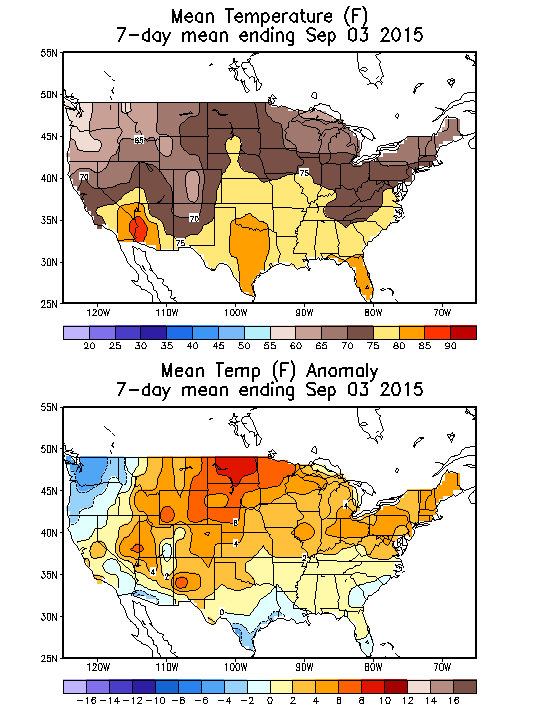
Source: NOAA/National Weather Service
Deviation between average and normal (°F)
7-Day Mean ending Sep 03, 2015

Source: NOAA/National Weather Service

